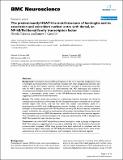The Predominantly HEAT-Like Motif Structure of Huntingtin and its Association and Coincident Nuclear Entry with Dorsal, an NF-kB/Rel/Dorsal Family Transcription Factor
Citation
Takano, Hiroki, and James F. Gusella. 2002. The predominantly HEAT-like motif structure of huntingtin and its association and coincident nuclear entry with dorsal, an NF-kB/Rel/dorsal family transcription factor. BMC Neuroscience 3:15.Abstract
Background: Huntington's disease (HD) pathogenesis is due to an expanded polyglutamine tract in huntingtin, but the specificity of neuronal loss compared with other polyglutamine disorders also implies a role for the protein's unknown inherent function. Huntingtin is moderately conserved, with 10 HEAT repeats reported in its amino- terminal half. HD orthologues are evident in vertebrates and Drosophila, but not in Saccharomyces cerevisiae, Caenorhabditis elegans or Arabidopsis thaliana, a phylogenetic profile similar to the NF-kB/Rel/dorsal family transcription factors, suggesting a potential functional relationship. Results: We initially tested the potential for a relationship between huntingtin and dorsal by overexpression experiments in Drosophila S2 cells. Drosophila huntingtin complexes via its carboxylterminal region with dorsal, and the two enter the nucleus concomitantly, partly in alipopolysaccharide (LPS)- and Nup88-dependent manner. Similarly, in HeLa cell extracts, human huntingtin co-immunoprecipitates with NF-kB p50 but not with p105. By cross-species comparative analysis, we find that the carboxyl-terminal segment of huntingtin that mediates the association with dorsal possesses numerous HEAT-like sequences related to those in the amino-terminal segment. Thus, Drosophila and vertebrate huntingtins are composed predominantly of 28 to 36 degenerate HEAT-like repeats that span the entire protein.
Conclusion: Like other HEAT-repeat filled proteins, huntingtin is made up largely of degenerate HEAT-like sequences, suggesting that it may play a scaffolding role in the formation of particular protein-protein complexes. While many proteins have been implicated in complexes with the amino-terminal region of huntingtin, the NF-kB/Rel/dorsal family transcription factors merit further examination as direct or indirect interactors with huntingtin's carboxyl-terminal segment.
Other Sources
http://www.ncbi.nlm.nih.gov/pmc/articles/PMC137586/pdf/http://www.biomedcentral.com/1471-2202/3/15
Terms of Use
This article is made available under the terms and conditions applicable to Other Posted Material, as set forth at http://nrs.harvard.edu/urn-3:HUL.InstRepos:dash.current.terms-of-use#LAACitable link to this page
http://nrs.harvard.edu/urn-3:HUL.InstRepos:4632529
Collections
- HMS Scholarly Articles [17922]
Contact administrator regarding this item (to report mistakes or request changes)



